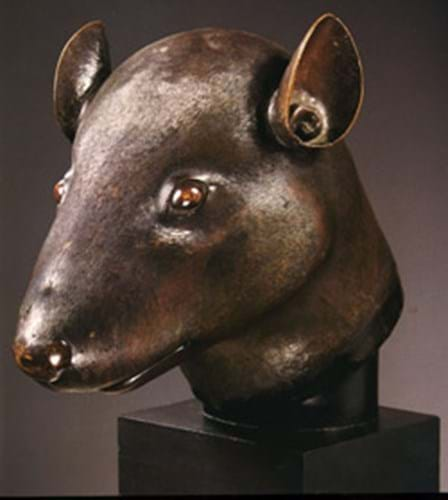
The extraordinary move follows repeated attempts by the Chinese government and private citizens to stop what they claim is the sale of treasures looted from China.
But dealers say they do no expect there to be a long-term fall-out in the market for Chinese works of art, citing this saga as a highly sensitive and special case.
The Qing bronze fountainheads of a rat and a rabbit were consecutive lots in Christie's three-day auction of the collection the late French designer Yves Saint Laurent, who had purchased them legally in the 1970s.
They once formed part of the Haiyantang Zodiac water clock designed by the Italian Jesuit missionary Giuseppe Castiglione (1688-1766) for the Old Summer Palace, but disappeared when French and British forces sacked and burned the palace complex in 1860, the final act of the second Opium War.
They were deemed among the highlights of the YSL collection, although their sale by auction was controversial and predictably upset the China's State Administration of Cultural Heritage (SACH). Bidding reached €14m (£12.7m) each on the evening of February 25.
The Fujian province auction house owner Cai Mingchao called a news conference on March 3 to announce himself as the buyer, but added that his winning bids were a patriotic act of protest. He would not - and could not - pay his bill. "These cultural relics belong to China. They were looted by the West in time of war and illegally taken abroad."
Mr Cai, an adviser to a Chinese non-profit group dedicated to repatriating relics, is a well known as a client to the major auction houses and the buyer of a number of big-ticket items, including a Ming Buddha for a record HK$117m ($15m) at Sotheby's Hong Kong in 2006. Accordingly, his request to bid by telephone for the heads would have raised little suspicion. "At the time, I was thinking that any Chinese would do this if they could," he told the state-controlled news agency Xinhua on March 3.
Mr Cai says he acted without the support of the Chinese government, although his behaviour will curry favour in Beijing. The Chinese government protested the sale in the days leading up to the auction - foreign ministry spokeswoman Jiang Yu called the relics "stolen and robbed" - but a lawsuit brought by Chinese cultural defence group Apace had been thrown out by a Paris administrative court on February 23.
The 1995 United Nations Unidroit Convention limits claims on stolen cultural artefacts to within 50 years of their theft.
In the immediate aftermath of the sale (before Mr Cai told his story), SACH publicly announced their intention to punish Christie's for their decision to proceed with the sale: "This has hurt the cultural rights and interests of the Chinese people and the national sentiment and will have a serious effect on Christie's development in China." With control over import and export documentation in and out of China, SACH have the power to make life difficult for Christie's, particularly in Hong Kong, their third largest market.
Christie's - who are associated with Chinese auction room Forever International - said they regretted SACH's "unusual step of announcing reprisal measures as a consequence of [the] legal auction of the fountainheads". They pointed out that the fountainheads had a clear and extensive history of ownership dating back over a century. Prior to the sale they had privately offered the heads to the Chinese government at a price "significantly less than the [anonymous] underbidder was willing to pay". That offer was rejected.
The actions of the Chinese government during this affair have placed a question mark over future sales of important Imperial works of art. Many works of art removed from China reside in Western public and private collections - particularly the Imperial porcelain vessels that were specifically targeted by British and French looters. They regularly appear for sale.
However, the Mayfair-based dealer Roger Keverne, chairman of the Asian Art in London event, believes this to be a special case. Artefacts taken from the Old Summer Palace at the end of the second Opium War had a symbolic significance for China, said Mr Keverne, and the 12 zodiac animal heads have become totemic of a site he describes as "a national humiliation monument".
The Old Summer Palace, known in China as Yuan Ming Yuan (the Gardens of Perfect Brightness), were put to the flame by British and French troops in October 1860, a cultural catastrophe still regarded as a symbol of overseas aggression and humiliation in China.
Despite calls to rebuild the site - a complex of palaces and gardens where the emperors of the Qing Dynasty resided and handled government affairs - the Chinese government has decided instead to preserve the ruins to teach future generations about the consequences of being dominated by foreign powers.
The appearance of other heads from the fountain on the market in recent years has created tension, albeit on a lesser scale. The $2m sale of a tiger's head at Sotheby's in 2000 sparked protests in Hong Kong. A horse head dur to be offered by Sotheby's in September 2007 was bought privately for $8.9m by Macau billionaire Stanley Ho who also bought the fountain's boar head in 2003 at a private sale. Both were donated to Beijing's Poly Museum, where the monkey and ox heads from the fountain already reside. The whereabouts of the other bronzes are unknown.
There has been no response from Christie's regarding Mr Cai or the status of the two heads, but it is understood Pierre Bergé had chosen to keep them.
"The issue has been completely overblown," said London-based dealer Ben Janssens. "The heads were made by a Western person in the 18th century and they've been in a Western collection for more than 100 years."
• The US State Department signed an accord with China on January 14 banning the import of Chinese antiquities dating from before 907AD if not accompanied by a documented provenance. The measure was passed in an attempt to combat the illicit trade in smuggled works of art.
By Roland Arkell




